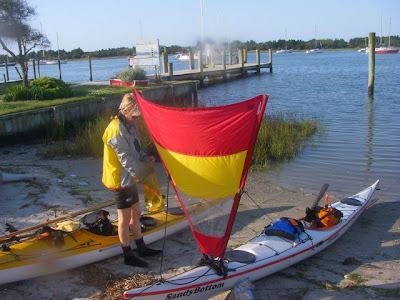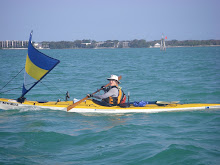
Day 3 of this year's
WaterTribe Everglades Challenge, just off the coast near Wiggins Pass, I unclipped from my PFD my beautifully sharp (and expensive!) non-rusted (at all!) two-year-old
Boye Pointed Tip knife (as above) to slice off a length of waterproof tape to relieve a hot spot on my palm. As I finished the effortless slice (how I loved that knife)--too effortlessly--it flew from my hands and spiralled down into the unseen depths below. For the rest of the EC I used either my teeth or borrowed SandyBottom's or KneadingWater's rusty, blunt PFD knives.
I was devastated by my loss. I really liked that (expensive!) knife.
After a suitable period of mourning, only now have I started the search for a new knife. Which got me thinking about doing a little more research into the intricacies of "the best" PFD-attached kayak knife, because, as we all know, research is half the fun of the purchase, particularly with anything related to water use.
First up is the debate on whether to wear a jolly knife on your PFD or not, which apparently is as heated as to whether to have a rudder on your kayak or not. Having been sold many moons ago on the "yes, I will wear one because it is a huge safety resource" side of the debate, I spent less time on the whys-and-wherefores. But, if you are still wondering yourself, Trevor Gardner of the NSW Sea Kayak Club has written an excellent article,
The PFD Knife: Don't leave home without it. He left me with this salutory reminder:
"... it really doesn't matter what knife is on your PFD as long there is a knife on your PFD. A good quality knife is one of the most important survival tools you can carry. However, if you can't locate your knife when upside down with your eyes closed then it's no longer a survival tool, it's ballast."
After having reconvinced myself that I do need a knife on my PFD, I was now left with the question, which knife should I replace my beloved Boye with. The Boye was a folding knife, and I must admit, it wasn't easy to open with one hand, which can be pretty necessary in a dodgy situation. In this respect, I'm now convinced I should carry a fixed blade that I can pull down from its sheath and is ready for action in one sweep.
And I'm also moving from the pointed blade to the blunt tip--for obvious reasons--as well as adding a serration or two.
I contemplated tying the dang knife on to my PDF so it couldn't fall overboard, but running through various rescue scenarios in my mind nixed that idea--all one needs is another jolly line floating around while upside down.
And I don't want a knife in the $100 range or above, just in case I do lose it overboard again. But I don't want something that's going to rust with just a season or two of use. I found that the two factors--price vs. rustability--tend to be linked.
Let me warn you now, you can spend hours Internet-researching for the perfect (cheaper) PFD knife. But what I believe I'll now end up with is the
Gerber River Shorty (as below). It's medium-carbon stainless steel, which isn't as robust as Boye's dendritic cobalt, but for around $30, I should be set.
Comments welcomed!

 Just returned from the inaugural WaterTribe North Carolina Challenge--more to come on that.
Just returned from the inaugural WaterTribe North Carolina Challenge--more to come on that.

















 It was still quite daylight when we repaired to our tents, each watching the Sound slowly calm as the wind died—though it continued to buffet our tents well into the early hours. And for 12 or so hours, we slept like logs…
It was still quite daylight when we repaired to our tents, each watching the Sound slowly calm as the wind died—though it continued to buffet our tents well into the early hours. And for 12 or so hours, we slept like logs… 






















